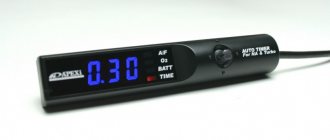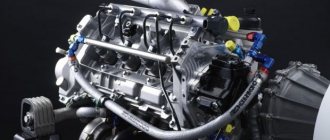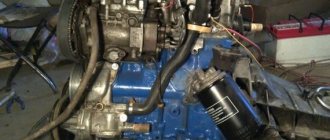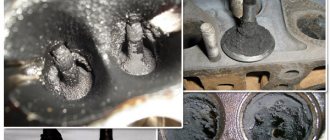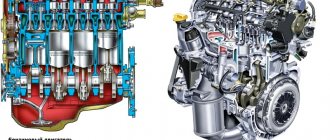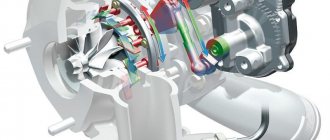Features of diesel engine warming up
In the opinion of many, it is better not to warm up an engine with a turbine while running, precisely because of the turbine, since it turns on only at the required crankshaft speed, which appears at high speed.
It is prohibited to develop high speed on a cold engine. Driving with the turbine turned off can lead to overheating of the engine, which will result in overheating of the cylinder heads and their rapid wear. A diesel engine needs to idle for at least 5 minutes, this is enough for all components to be properly lubricated (if, of course, the glow plugs are in working condition). The developers advise heating the spark plugs twice. When their indicator on the panel turns off, it means that the voltage in them has turned off, although most people think that this happens if the maximum temperature is reached.
Warming up for too long will lead to the appearance of resin deposits on the valve, which can cause the valves to begin to lock in the future.
Many experts argue that there is no point in warming up the engine for a long time if it is filled with high-quality oil and coolant. It was found that when the engine is cold, there is practically no depreciation of the elements if the car is traveling at low speed. The revolutions accordingly also do not exceed two thousand, thanks to which the required temperature can be achieved quickly.
Diesel fuel evaporates much worse when warmed up. After starting the unit in a cooled engine, the fuel begins to settle on the surface of the cylinders and does not burn completely. As soon as the temperature reaches normal, the fuel assembly in the chamber burns evenly and completely.
Remember that the components of the internal combustion engine do not heat up equally; some of them require more time. The heating time also depends on what material the unit parts are made of (usually pistons, cylinders, shafts are made of aluminum alloy, everything else is made of metal).
Good lubrication of the rubbing elements and optimal setting of gaps is carried out exclusively after the internal combustion engine reaches the required temperature.
Warming up the engine in winter and summer
In summer, warming up the engine is strongly recommended. The movement should be started only a minute after the engine has started, since it is during this period of time that all elements are lubricated with oil. To reduce excessive load on the engine, it is better not to make sudden movements and move smoothly before the temperature approaches fifty degrees.
Operating a diesel engine in the winter requires complete warming up, since the oil in the engine and gearbox begins to thicken at low temperatures. The oil should become liquid and only then can you gain high speed. The duration of warming up depends on the air temperature; the lower it is, the longer you will need to wait.
The movement should begin when the temperature reaches 60 degrees. In this case, it is recommended not to gain speed more than two thousand, and the speed should not exceed twenty km/h until the temperature reaches normal. In addition, it is better not to turn on the cabin heater until the engine warms up to sixty degrees, otherwise the air flow coming from it will be cold.
All of the above tips will help the driver save time and avoid further problems with the diesel unit, as well as significantly extend its service life.
How long does it take to warm up the engine?
If you decide that you will warm up the engine before driving, then the next question will arise: “How long will this take?” To achieve the required operating temperature, 7 minutes is enough, during which time the oil will become more liquid and the speed will drop. In order not to waste time, you can sweep the snow from the car and remove the ice on the windows and mirrors.
Do not rush to press on the gas right away; the tachometer needle should not rise above 3 thousand revolutions. The transmission also experiences increased loads when starting to move, because thickened oil interferes with gear shifting.
To determine whether you can start driving, pay attention to the temperature sensor. If the needle reaches 60 degrees in winter, then you can drive calmly: in summer, the operating temperature is considered to be 50 degrees.
But no one forbids you to start driving at lower speeds; you will have to choose a smooth driving style and not accelerate. In this case, the engine cannot produce maximum power and more fuel is wasted.
Operating diesel engines in winter - main points
Car parking . Experts recommend, if possible, keeping the diesel engine in a more or less warm room. As a last resort, this should be a closed shelter that will protect the car body from the accumulation of snow and ice. Even if the temperature in the garage is only a few degrees higher than outside, this will speed up the warming up much faster.
Fuel tank condition . The fuel tank should be as full as possible. Condensation in the fuel tank can eventually freeze and cause a host of problems. Therefore, before parking the car, it is advisable to completely fill the fuel tank to eliminate the possibility of condensation forming. You can also reduce this risk by adding special anti-freeze additives to the fuel.
Warming up the engine . And although there is a lot of controversy on this subject, most experts insist that a cold diesel engine needs to be warmed up before driving. Ideally, it should warm up for at least five minutes. Otherwise, the engine may work harder and burn excess fuel.
Summer and winter diesel fuel
Diesel fuel has different cetane numbers. The higher it is, the more volatile the fuel will be. Under standard conditions, diesel with a lower cetane number is used. Drivers who know how to save fuel can tell their less experienced colleagues that when driving fast or hauling cargo, less volatile fuel is used more slowly and is therefore more economical. However, like any fuel and lubricant, diesel fuel becomes thicker and more viscous at low temperatures and in extreme conditions, regular diesel can become so thick that it stops flowing altogether. Therefore, for driving in very cold weather, you will have to fork out for Arctic diesel fuel with a high cetane number. Moreover, it is highly advisable to choose fuel with a reserve. That is, so that its operating temperature is 10 degrees lower than the expected ambient temperature.
engine life
Under the influence of negative temperatures, the geometry of the metal elements of the internal combustion engine changes - they compress and decrease in size, which causes the appearance of excessive gaps and backlashes. In addition, the load on a diesel engine is higher than on a gasoline engine - it’s all about the high degree of fuel compression. That is, the wear and tear on working diesel components increases significantly.
In this case, preheating will help return the metal to its original shape, remove gaps and prevent excessive load on the pistons.
Transmission
The ATF fluid (transmission oil) in an automatic transmission also thickens in cold weather. And warming it up to the required temperature is a prerequisite for the normal operation of the “machine”. Only in liquid oil will gear shifting be carried out clearly and smoothly, and the box itself will last quite a long time. Otherwise, the automatic transmission elements will quickly fail and the oil will require replacement.
For manual transmissions, too, preheating the oil inside the box will not be superfluous: the driver feels how hard the gears of the “mechanics” turn in the oil thickened in the cold when changing gears.
driver comfort
In some car models, it will not be possible to completely remove ice from the glass, inside and out, until warm air comes out of the heater deflectors. And sitting in a warm cabin is much more pleasant. All these conditions will be ensured only by a preheated engine.
Therefore, it makes sense to focus on the moment when warm air begins to flow from the air ducts - and only after that start moving.
Is it worth warming up a diesel engine?
Diesel engine oil has one very unpleasant feature - it thickens. Even winter oil at low temperatures becomes too viscous to serve as a lubricant for components. In addition, thickened oil will cause the engine to not start, since the oil pump has difficulty pumping it.
Not always and not in all engines there is enough oil film to start the system. Also, this film is quickly washed away by the fuel that is supplied to the engine, so there is a risk that the engine will stall after a few minutes of driving without warming up.
To avoid this problem, the engine must be warmed up. At idle, the engine will quickly reach the required temperature and dilute the oil to ensure lubrication of the pistons and cylinders.
Practice
So, based on the above, it becomes clear that starting a diesel engine in the cold season is very problematic. Moreover, the property of diesel fuel to thicken and solidify at low temperatures plays a special role here. This is why many car owners who operate their cars in our harsh climate use winter fuel almost constantly, or at least most of the year. It would also be quite logical to warm up the diesel in the winter if you do not want to be a regular customer of service centers due to the repair of fuel equipment.
Let's imagine a normal winter situation. You have decided to start your car. What happens? When you turn the key in the ignition or press the “start” button, the starter turns (or tries to turn) the crankshaft of the engine, all the rubbing parts of which are lubricated with frozen engine oil. At the same time, the fuel equipment works to pump diesel from the tank along the fuel line through the filter and spray it into the combustion chamber. If the diesel fuel meets the conditions in which it is currently used, then the process of submitting it occurs correctly. If it does not match, the engine will not start.
In general, it is clear that during a cold start, all parts of the crank mechanism of the internal combustion engine, the fuel equipment of the diesel engine and the starter experience enormous loads. This is the reason for a significant reduction in their resource. And if you start actively using the car immediately after it starts, the load on all components increases many times over. There is a big risk of screwing up the engine. Naturally, warming up a diesel engine in winter is not just desirable - it is necessary! And in order to minimize the risk of “death” of the fuel equipment, it is recommended to generally warm up the diesel in the winter, even if you use winter and Arctic types of diesel fuel, and you are sure that the fuel is in a liquid state.
There is another simple, but nevertheless compelling argument in favor of why it is necessary to warm up a diesel engine with a turbine in cold weather. In the case of diesel fuel, you need to be 100% sure that while driving the fuel filter will not become clogged with crystals of solidifying diesel, and the car will not stop halfway. Why do you need these problems? Isn’t it easier to warm up the car at idle to operating temperatures (or at least 40-50 degrees), making sure that everything works as it should? Or is it better to go right away and then break down on the road a couple of minutes later? I think most sane people will choose the first option.
How long does it take to warm up a diesel engine in winter?
How long does it take to warm up a diesel engine? Well, probably the same as a gasoline one - up to the optimal operating temperature regulated by the automaker. In terms of time - as long as it takes to do this, warm it up.
How long should you warm up a diesel engine in winter? Likewise. Another thing is that in cold weather the time required to warm up increases significantly. It's clear that everyone is always in a hurry. Therefore, let's say this: the minimum temperature at which it is advisable to start operating a diesel engine is 40-50 degrees Celsius. Typically, about 10 minutes of warming up is enough to reach this temperature.
In general, in recent years, developed countries have taken the environment very seriously. Therefore, various bans related to the operation of cars with internal combustion engines are constantly being introduced. Warming up cars - including. In principle, we are also starting to prohibit warming up cars for a long time in the courtyards of residential areas.
Where should we, car enthusiasts, go? Should we obey and obey the law, “ruining” our cars, or should we warm up in defiance of the law, while polluting the environment? I think everyone must decide for themselves what to do. But in general, there is a solution to get out of this situation. For our money, of course, but yes.
Pre-heaters
It is clear that it will not be possible to warm up the engine quickly. We cannot influence the internal processes in any way. Therefore, in order to comply with the law and preserve the engine, they came up with so-called “pre-heaters”. The essence of their use is to warm up the engine in winter before starting. And not only the engine. In the case of a diesel engine, a pre-heater is especially important, because You can preheat both the lubricant and (most importantly) the fuel to operating temperature. Therefore, I think this is the best solution for a diesel car in winter.
How to properly warm up a diesel engine?
The warming up procedure is simple and will not take much time, but will have a positive effect on the service life of the engine.
There are two ways to warm up:
- After the car has been started, you need to let the engine idle for about 3 minutes. Then you can start driving, but during this time the engine and all its components will not be able to fully warm up, so for 10 minutes it is better not to give the load above 2500 rpm.
- Do not start driving until the temperature, according to the sensor, rises to 60 degrees in winter and 50 in summer. However, even after this, the first time you should move smoothly, since a not fully warmed-up engine consumes more fuel.
Concern for the environment in many countries has led to the fact that warming up a gasoline or diesel car is prohibited by law. Moreover, in the operating manuals, the car manufacturers themselves recommend starting to drive immediately and warming up the engine while driving. It is quite obvious that the service life of the units was simply relegated to the background, since in developed countries the model range is updated approximately every 3-4 years, and during this period (100-150 thousand km) the engines are well maintained.
Possible problems
The turbocharger heats up to 1000 degrees during operation. The hot gas of the exhaust system passes through the “snail” and spins it over tens of thousands of revolutions. The turbine heats up, and in this case it is very important to maintain a balance of operating temperatures. Therefore, in cold weather it is necessary to operate the turbine correctly.
When parked overnight in the cold, the turbine cools down greatly. The rubbing parts of the snail, shafts, bearings and other components change in size due to thermal expansion. In addition, the oil settles overnight and the working surfaces experience a shortage of it. During a cold start, you cannot immediately load the turbine due to the risk of active wear. At the moment when the engine speed rises above 2.5 thousand, the turbine enters operating modes and pumps air into the mixture preparation system. The “snail” heats up sharply, and there is an active thermal expansion of the materials of the parts. In a matter of moments, the gaps between the rubbing surfaces can change up to several microns, which is why there is a risk of rupture of the oil film and damage to the working surfaces. Thus, even after a couple of hours in the cold, the engine must be properly warmed up before driving. Otherwise the turbine is finished.
The first signs of a dying turbo are unusual noises that appear after starting the engine. An extraneous hum or whistle is heard. At the same time, bluish smoke comes out of the exhaust pipe, and increased oil consumption is observed. The lubricating fluid penetrates through the gaps in the retaining rings and is pumped along with air into the exhaust system. After warming up, the noise and smoke disappear, but the engine noticeably loses throttle response. The turbine cannot provide the normal level of air pressure, causing engine power to drop.
Meanwhile, even with a well-warmed engine, increased oil consumption continues. The oil passes through the resulting play to areas of high temperatures, and carbon deposits appear on the bearing shafts, which first unbalances the “snail” and then provokes the gradual destruction of bearings and other parts. And this happens due to improper driving in a cold car in the first minutes after the start.
Turbo timer and circulation pumps
The recommendation immediately gave rise to the emergence of new electronic gadgets - turbo timers.
After turning the ignition key, the engine will run for a couple of minutes at minimum speed to cool the turbine and extend its service life. Developers of security systems were among the first to offer turbo timers, adding a new function to the alarm system for owners of turbocharged cars. The supply began to be in demand, and therefore separate electronic units appeared that perform the function of delayed engine shutdown. Turbo timers are not routinely installed even on cars with charged engines. And not because the problem has disappeared somewhere - nothing has fundamentally changed in the internal combustion engine. Yes, designs, materials and lubricants have changed and become more advanced, but turbochargers still do not like overheating. Maybe automakers use other means of protecting turbochargers from overheating?
Some companies (in particular, Porsche, Volkswagen, Skoda, Jaguar) install electric circulation pumps on many turbocharged models, which, if necessary, supply coolant to the turbocharger. Even after stopping the engine, antifreeze circulates through the unit for some time, preventing it from overheating. Reminiscent of a similar mode of operation of electric cooling system fans, implemented on most modern cars. The motor is turned off, but the fan continues to spin. It is clear that in this case there is no need for a turbo timer.
Many automakers shift the function of the intelligent turbo timer to the driver! Most instructions note that after operating the car in conditions close to the maximum permissible, it is recommended to let it run without load for several minutes before turning off the engine. That is, the advice remains the same as decades ago.
Last year, out of the 25 best-selling models in Russia, five were equipped with turbochargers. At the same time, an additional electric pump that cools the turbocharger is used in three models: Skoda Kodiaq, Skoda Octavia A7 and VW Tiguan. It turns out that most manufacturers of relatively affordable cars do not bother with such problems. The logic is simple: there is no increase in price, and the car is most likely out of warranty anyway. What next is the owner's concern.
Do not turn off the engine immediately - let it run at minimum speed. The operating conditions of a turbocharger are very difficult, and no innovations have appeared that would make it immortal.
Cylinder piston group and crankshaft
It is worth considering that warming up of a diesel engine is not uniform. Some parts heat up faster, others still remain cold. The internal combustion engine elements are made of metal and aluminum alloys (crankshaft, cylinders, pistons, shafts, etc.). As you know, when heated, the body expands, and the heating time and expansion coefficient depend on the material of manufacture.
It turns out that only after the motor reaches operating temperatures are optimal thermal clearances established and the rubbing pairs are properly lubricated. For this reason, immediate start of movement and additional loads on a cold engine reduce its service life.
Combustion of fuel
According to manufacturers, the fuel injection systems of modern diesel engines allow you to move immediately after starting the engine; diesel fuel is atomized in the cylinders in such a way that diesel fuel does not wash away the oil film from the surface of the liners.
One way or another, at low air temperatures very often diesel fuel becomes more viscous and its fluidity decreases. The performance of a diesel engine is also affected by the cetane number of diesel fuel, the presence of various impurities and additives, as well as the overall quality of the fuel. Pre-heaters, glow plugs and other solutions are designed to make starting easier, but the efficiency of fuel atomization by diesel injectors still depends on the internal combustion engine reaching operating temperatures. Additionally, it is worth considering that the supply of cold outside air leads to a general decrease in the temperature inside the cylinder.
The volatility of diesel fuel in the warm-up mode deteriorates noticeably. The unit starts, but in a cold engine the diesel fuel settles on the cylinder walls and does not burn completely. If you add loads during movement to this, then the operating conditions for the motor become quite difficult.
For this reason, a diesel engine in winter needs a certain warm-up before driving and increasing loads. As the temperature rises, fuel combustion in the chamber becomes uniform and complete.
Heating the engine oil
The design features of diesel engines, compared to gasoline engines, require reduced gaps that are present between the cylinder wall and the piston. Diesel-fuelled internal combustion engines have a high compression ratio, which also means serious loads on the cylinder-piston group.
Part wear is minimized by engine oil. During the cold season, the lubricant in the engine crankcase thickens. After inactivity, only a small oil film remains on the cylinder walls and surfaces of rubbing parts.
After a cold start, the effective operation of the lubrication system begins from the moment the internal combustion engine reaches operating temperature (the oil finally liquefies, heats up and begins to operate under optimal conditions). Turbocharged diesel engines additionally require a high-quality supply of heated engine oil to lubricate the turbocharger. The resource of a diesel engine turbine directly depends on this. It is logical that the oil needs to be warmed up a little at idle, and when you start driving, do not subject the engine and turbine to loads until they are completely warmed up.
Cold car interior and frozen windows
It is unlikely that you will be able to clear the glass of ice in cold weather; it will be easier to do this when the heater turns on and the interior warms up. And sitting in a cold cabin, even with heated seats and steering wheel, is not entirely comfortable. And if there are no heated seats, then sitting on a cold one is very harmful. Therefore, to ensure comfortable driving conditions, it is better to warm up the engine.
What's the result?
To answer the question of how and how long to warm up a diesel engine at idle in winter, it is necessary to take into account the specifics of engines of this type. First of all, a diesel engine has high efficiency; it is difficult to warm up such an engine at idle speed in cold weather. The second nuance is the fact that the operation of the internal combustion engine in idle mode (minimum speed) means low oil pressure in the engine lubrication system and refers to severe operating conditions.
After such warming up, you can smoothly start driving in a lower gear and at low speeds. In the warm season, no more than 1-2 minutes of warming up the diesel engine before driving will be enough, and during the ride the engine will quickly and completely warm up.
Finally, let’s add that not only the engine, but also the transmission requires warming up. Automatic transmissions of the torque converter type, which are also filled with oil, are especially sensitive to “cold” loads. Special transmission oils in automatic transmissions act not only as a lubricant, but also as a working fluid, which is supplied to the gearbox components under pressure.
How to properly warm up a car engine. Features of warming up engines with a carburetor, injector and installed gas equipment, as well as diesel engines.
What temperature of a diesel unit is considered optimal. Diesel does not warm up, possible malfunctions and consequences of driving on a cold engine.
Causes of vibration and unstable operation of a diesel engine in idle mode. Possible causes and fault diagnosis.
Causes of difficult “cold” starting of a diesel engine. Compression, glow plugs, diesel injectors, injection pump, paraffin or water in the fuel system.
The engine does not reach operating temperature, the engine temperature arrow does not rise during warm-up or falls while driving: causes of the malfunction.
Starting the engine of a car that has been standing idle for a long time. What you need to check before starting the engine: fluids, transmission, brakes.
Source
Pros and cons of warming up a diesel engine in winter
On the topic of warming up a diesel engine in winter, many manufacturers say that modern turbo engines have a fuel injection system that allows you to start moving immediately. This is justified by the fact that the oil film is not washed off from the liners by fuel due to the correctly implemented supply of diesel fuel.
However, the fact remains that the oil thickens, and the diesel fuel also becomes viscous, and until it reaches the necessary parameters, it is still not worth starting to move.
We recommend, in our winter conditions, if possible, to warm up the engine to at least 40-50 degrees before the trip.
Advantages of warming up the engine at low temperatures:
- Optimal distribution of engine oil inside the engine, resulting in reduced wear. The engine is not subject to accelerated wear.
- The car has a smoother ride.
- Fuel economy. For the same time interval (10 minutes), the difference can differ by 3-4 times.
- Driving in a warm interior is much more pleasant.
Disadvantages of warming up the engine:
- Environmental pollution.
- Spark plugs are subject to high stress.
- Waiting for the engine to warm up.
DEATH TO THE MOTOR...
About the fact that during startup and warming up it increases sharply
engine wear
, only the lazy didn’t write. Not so long ago, a bearded professor on the screen convinced people that one cold start is equal to 100 km! He, of course, knows better, but we would never give such EXACT figures - they are completely different. And the engines are different, and the temperatures outside, and the oils poured into the pan, and the mileage with which they are compared can also be either outside the city or in city traffic jams. Therefore, in our opinion, the equivalent of 20 to 200 km is fairer: the main thing is the trend. And it is important that driving without warming up does not allow engine parts to prepare to accept heavy loads. They have a bad time - and not just the bearings.
Warm to victory
Some car owners believe that the diesel engine must be heated at idle until the coolant temperature rises to 70°C. Another option is until the speed drops to idle. The feasibility of such an approach seems questionable. Let's figure it out.
Due to its design features, a diesel engine heats up less at idle than a gasoline engine, and the whole car warms up worse. To achieve a noticeable increase in temperature in winter , you have to warm up the diesel engine for 30 - 40 minutes. During this time, a noticeable amount of fuel is consumed. For example: a three-liter diesel engine will “burn” approximately 200 ml of fuel during 20 minutes of warming up at idle speed.
A noticeable increase in the temperature of the power plant occurs in the first two minutes after startup. Subsequently, there is very little progress. Should you waste fuel and time for a small improvement in performance? Doubtful.
How to quickly warm up a diesel engine in winter
Content
One of the most discussed topics among motorists is the need to warm up a diesel engine in winter . This question is relevant for power plants with a turbine and “search” is the same. Almost all drivers were divided into two camps: those who warmed up the car, and those who consider it a waste of fuel and time.
What do manufacturers advise?
To the question: Is it necessary to warm up a diesel engine in winter? Today, manufacturers give a clear answer. “there is no need to warm up the internal combustion engine.” It is worth understanding what this statement is based on. Why do the same manufacturers advise warming up engines, but now they have dramatically changed their point of view.
Many car manufacturers claim that their products are so advanced that they work flawlessly even without heating. They begin to explain that previously both engines were primitive and mineral oils, that scientific and technological progress had not been achieved. Well, they don't say about water that it's wet.
Where is the dog actually buried? First: manufacturers are not interested in keeping the engine running longer than the warranty period. The sooner a car becomes unusable, the sooner the owner will buy a new car. Sales and repair of spare parts are additional sources of income for corporations. Why miss out on this profit? Therefore, it is profitable for manufacturers to tell tales that the “ultra-reliable” modern diesel engines do not need to be heated.
The second reason why major experts do not recommend warming up engines. it's about caring for the environment. When a diesel engine warms up, a large amount of exhaust gases are released into the atmosphere. It is not uncommon in cities where the owner warms up the car for 30 minutes instead of 10 minutes. before work. In Europe, environmental concerns are outpacing economic viability. We have the opposite. We are not saying whether this is good or bad, we are simply stating facts.
>
READ Nissan X Trail T31 Which Diesel
Interestingly, the same experts confirm that the main wear of engine parts (about 75%) occurs during a cold start. That is, they know that the motor is not suitable for operation when it is cold, but they do not advise heating it up. It's strange and unclear.
The theory of warming up a diesel engine in winter
The engines are made of metal. Pistons are usually made of light aluminum alloys, and cylinders. made of steel or cast iron. When heated and cooled, these parts expand or contract respectively. All engine components are designed to provide a minimum clearance between the piston and cylinder. This is the key to efficient use of fuel energy.
When the engine is cold, the clearances between the pistons and cylinders are not within design parameters. Until the temperature rises to the operating level, the engine will not operate in the mode specified by the manufacturer. Under full load, the wear of parts will increase, resulting in a shortened service life or an accident.
Besides the coefficient of thermal expansion, there is another problem. Oil viscosity. This parameter greatly affects engine performance. If fat thickens in the cold, it cannot completely lubricate the parts, which leads to increased friction in all pairs. Wear increases manifold when the engine is running under load.
Obviously, driving with a cold diesel engine is not a good idea. Another question arises: how to warm up a diesel engine in winter . Can this be done at idle? What is the optimal duration? We get it together.
How long does it take to warm up a diesel engine in winter?
There is no consensus among “diesel engineers” on this matter. This camp is disputed by how long a diesel engine warms up in winter , as well as by owners of gasoline cars.
Warm up to victory
Some car owners believe this is a diesel that needs heat at idle until the coolant temperature rises to 70 ° C. Alternatively. until the speed drops to idle. The possibility of such an approach seems doubtful. Let's see.
READ How to open the hood on a Solaris from the outside
Due to its design features, a diesel engine idles less than a gasoline engine, which worsens the performance of the entire machine. To achieve a noticeable increase in temperature in winter , you will have to warm up the diesel engine for 30-40 minutes. During this time, a significant amount of fuel is consumed. For example: a three-liter diesel engine will burn about 200 ml of fuel in 20 minutes at idle.
A noticeable increase in the temperature of the power plant occurs in the first two minutes after startup. There is little progress in the future. Is it worth the fuel and time for a little improvement? This is doubtful.
Warm, but without fanaticism
Other drivers for “ how to warm up a diesel engine in winter ” They answer briefly and clearly: “Wise. “In their opinion, it is enough to give the engine a couple of minutes to heat the oil in the crankcase and then start moving. Main. do not give the engine full load until the temperature rises to the optimum level. You can monitor this with a coolant sensor.
Proponents of this method of warming up a diesel engine in winter Keep in mind that the engine warms up faster. In addition, when the car is moving, the transmission and chassis become more active. Everything looks reasonable.
Objectively: how to warm up a diesel engine in winter
From a technical point of view, warming up a diesel engine in winter is vital. Taking into account the technical features and mechanics of automobile systems, you can figure out how to heat diesel engines.
At low temperatures, the engine must be started with a full supply of fuel. The clutch is tight. The engine warms up for two to three minutes. The crankshaft rotation speed gradually increases to medium. When the unit indicates that the coolant has reached 40°C, it means the engine is ready to be loaded.
In addition, the engine warms up in low gears at low speeds. When the coolant temperature reaches 75°C, you can drive as the road situation allows.
The spark plugs must be fired several times to make the diesel engine easier to start. These devices are built into the design of modern diesel power units. They help warm the air entering the combustion chamber. In a diesel engine, ignition occurs as a result of heating the highly compressed air-fuel mixture in the cylinder. The heated air will make starting easier.
READ Replacing the Front Wheel Bearing of Daewoo Nexia Video
What do we get from performing this engine warm-up algorithm? In the first two minutes after starting the engine, the oil in the crankcase heats up enough to completely lubricate the cylinder-piston group. A smooth start to movement helps to warm up the transmission oil and “develop” the suspension. While driving, diesel heats up faster. Reduces fuel consumption. After 5 minutes of driving, you can turn on the interior heating, which will speed up the engine warm-up.
From the point of view of the engine, "walking" and other automotive systems, this method is the most logical. Practical observations show the effectiveness of this method. The gentle starting mode helps protect the diesel engine from breakdowns in frosty weather.
How to make a diesel engine with a turbine warm in winter
Recommendations for turbocharged diesel engines are no different from those for naturally aspirated counterparts. In the same way, you should start the engine, warm it up for a few minutes and start driving at low speed in first gear. Warm-up time while driving is about 5 minutes, during which time use no more than third gear. Monitor the heating of the diesel engine based on the coolant temperature.
The use of special preheaters gives good results. Additionally, it would be inappropriate to lighten your engine with special additives. antigels. They do not allow diesel fuel to thicken in the cold. Many car owners have difficulty starting diesel engines due to condensed fuel. It is especially difficult in winter if the car is filled with summer diesel fuel.
We tried to give a complete answer to the question of why and how to warm up a diesel engine in winter . We hope that you will be able to draw the right conclusions to protect the “heart” of your car from breakdowns on frosty days.
Source
Warm, but without fanaticism
Other drivers answer the question “ how to warm up a diesel engine in winter ” briefly and clearly: “wisely.” In their opinion, it is enough to let the engine run for a couple of minutes to warm up the oil in the crankcase, and then start driving. The main thing is not to give the engine full load until its temperature rises to the optimal level. You can monitor this indicator using the coolant sensor.
Proponents of this method of warming up a diesel engine in winter believe that the engine warms up faster while driving. Also, when the car is moving, the transmission and chassis heat up more actively. Everything looks reasonable.
How long does it take to heat a diesel engine in winter?
There are no specific instructions on how long to heat a diesel engine in winter. Do this at idle or while driving. Warming up the engine is not such a tedious and time-consuming task.
While you are clearing snow from your car or warming up the windows, the engine will warm up slightly. And then you can start moving without overloading it too much. The optimal warm-up time for a diesel engine while driving in winter is about 8-10 minutes. This time is enough for the coolant to warm up to 40-50 degrees.
In order to warm up a diesel engine in winter, you need to turn on the ignition and start the engine. Let it run for a bit and then start driving, about 8-10 minutes will be enough at low speeds.
After the diesel car engine warms up slightly (approximately 45 degrees), you can load the power unit more. While it has not warmed up, the driving style should be smooth, avoiding sharp accelerations and high speeds of the power unit. The engine will warm up completely while driving.
We do not recommend starting to drive if the engine temperature has not reached 40-50 degrees. If this cannot be avoided, for the first few kilometers do not gain speed above 2 thousand, and do not accelerate more than 40 km/h. Remember that the operating temperature of the engine is 80-90 degrees, and until it warms up you should not subject it to excessive loads. Otherwise you will destroy him.
Is it necessary to warm up the turbodiesel at idle speed first? Yes, it is necessary, you need to spend the same 5-8 minutes on this. Although it warms up slower than its gasoline counterpart. After warming up at idle, the engine is usually warmed up while driving.
How to warm up a diesel engine with a turbine in winter
Recommendations for turbocharged diesel engines are no different from those for atmospheric counterparts. In the same way, you should start the engine, warm it up for a few minutes, and start driving at low speeds in first gear. Warm-up time while driving is about 5 minutes; during this time, use no higher than third gear. Monitor the warming up of the diesel engine using the coolant temperature.
A good result is achieved by using special pre-heaters. It would also be a good idea to make life easier for your engine by using special additives - anti-gels. They prevent diesel fuel from thickening in the cold. Many car owners have difficulty starting diesel engines precisely because of thickened fuel. It is especially difficult in winter if the car is filled with summer diesel fuel.
Warming up the engine in summer
Summarizing all of the above, we can say: warming up the engine is necessary. But does the engine need it in summer or only in winter? After all, in summer the engine oil does not thicken, technical fluids are normal...
Yes, in summer there are more gentle conditions for starting the engine, but, as mentioned above, a certain temperature is required for optimal engine operation. And if in winter warming up the engine can last 5, 10, or 15 minutes, depending on what the temperature is “outside”, how long the car has been standing, outdoors or indoors, and so on, then in summer this time, of course, is significant decreases. And the warm-up is already more reminiscent of the aforementioned “warm-up on the go.” But initial warming up to at least an engine temperature of 40–50 ℃ or until the idle speed is reduced if you have an automatic transmission is necessary!
Source
Harmfulness
Warming up a diesel engine is prohibited by law in some states. But it is worth remembering that the emissions of harmful substances from diesel are less than from gasoline. But diesel exhaust will not cause global harm to the environment, but it will easily extend the life of the engine.
Advice! Do not start your journey on a cold engine, or rather, wait until it reaches a temperature of at least 40 degrees. He can catch up with the rest on the way. But still, stick to the minimum value, since the operating temperature is 90 degrees.
Warming up the engine is an integral part of driving a car. In addition, this process does not take much time, which can be spent to benefit yourself and your car. Just don’t warm up your diesel engine under your neighbors’ windows, as it’s at least not polite.
Sources
- https://avtodvigateli.com/sovety-po-ehkspluatacii/progrev-dizelnogo-dvigatelya.html
- https://topdetal.ru/stati/ekspluatatsiya_i_progrev_dizeley_zimoy/
- https://www.dieselkraft.by/poleznaya-informatsiya/kak-i-skolko-nuzhno-progrevat-dizel-zimoj.html
- https://25cars.ru/sovety/progrevat-dizelnyj-dvigatel-zimoj.html
- https://aif.ru/auto/support/kak_morozy_ubivayut_turbirovannye_motory
- https://www.zr.ru/content/articles/923224-ostanovka-po-trebovaniyu/
- https://KrutiMotor.ru/dlya-chego-progrevat-dizel/
- https://auto-word.ru/skolko-gret-dizel-zimoj/
- https://autoassa.ru/blog/nuzhno-li-progrevat-dizelnyj-dvigatel-zimoj/
- https://AvtoSotka.ru/obzory-i-novosti/nado-li-gret-dizelnyj-dvigatel.html
- https://zen.yandex.ru/media/etlib/skolko-trebuetsia-vremeni-dlia-progreva-dizelnogo-dvigatelia-5c48511e54a86e00ad0e3bfa

